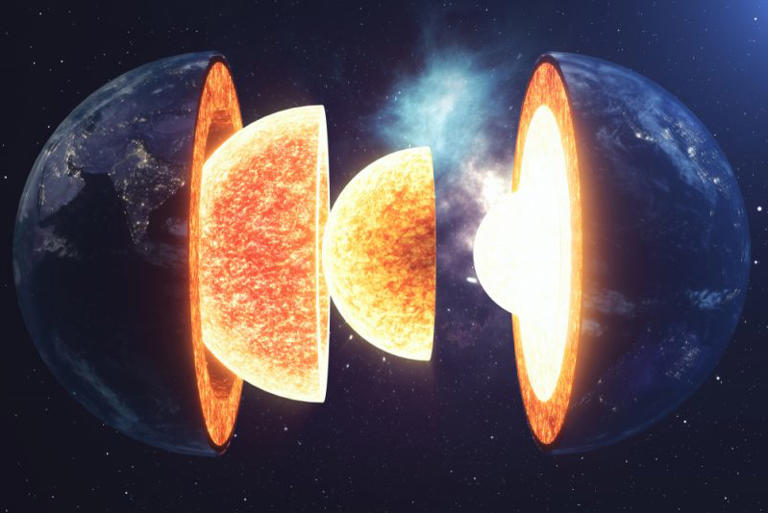
When the Earth was still in its early stages of formation billions of years ago, it was surrounded by a global ocean of molten magma. This environment was vastly different from the conditions we experience today. However, this period played a crucial role in shaping the Earth’s chemical and physical structures.
Recent seismic imaging studies have revealed large enigmatic structures in the Earth’s mantle. These structures, located in the lowermost mantle, are believed to be remnants of the ancient global magma ocean. One key element in understanding these structures is iron, which tends to concentrate in the magma rather than the crystallized rocky layer of the mantle.
To further investigate this phenomenon, an international team of scientists, including researchers from ASU, conducted experiments using high-power laser beams to subject silicate magma to extreme pressures and temperatures. The experiments revealed that under these conditions, iron atoms rearrange their electronic structure into a low spin state, resulting in a denser state.
This atomic-scale transformation provides an explanation for why the magma becomes denser than crystals as the magma ocean solidifies, contributing to the formation and persistence of the observed structures in the deepest part of the mantle.
The findings also have implications for understanding super-Earth exoplanets, which are rocky planets with larger radii than Earth. The experiments reached pressure conditions similar to those expected in super-Earths and suggest that magma densification could occur to a greater extent in their magma oceans. This could potentially contribute to the generation of magnetic fields, which may then shield these planets’ thin atmospheres.
Overall, this research sheds light on the mysteries of iron atoms in ancient magma and provides insights into the early stages of Earth’s formation as well as the potential conditions of super-Earth exoplanets.
Sources:
– Science Advances (2023). DOI: 10.1126/sciadv.adi6153
Platinum and gold are common, if expensive, in watches, necklaces, and rings. There’s also platinum in our electronic devices, rhodium in catalytic converters, and palladium in dental crowns. Most of us don’t realize how incredible it is that these rare metals are here at all, let alone in such quantities.
The density of precious metals in the Earth’s mantle is much higher than it should be, but why? Researchers have long believed that they came aboard giant space rocks that collided with our planet just after it formed. But over time, they should have sunk into the Earth’s core. How did metals like gold and platinum end up so near the surface?
Snapshots from mixing simulation in Earth’s mantle, from right after an impact (top) to present (bottom). Image: Korenaga and Marchi 2023© Provided by ExplorersWeb
Gold, platinum, palladium, rhodium, iridium, osmium, rhenium, and ruthenium, those elements that came to Earth through impacts from giant asteroids and protoplanets, all bind easily to iron. But instead of sinking to our planet’s iron-rich core, they remained relatively near the surface, in the mantle. A very lucky, but also confusing phenomenon.
Two scientists, Jun Korenaga and Simone Marchi, carried out simulations to try and replicate what happened after these ancient collisions. They think they have solved the mystery.
As the huge space rocks smashed into our young planet, the huge impact created an ocean of molten magma in the crust and upper mantle. This ocean trapped the metals. The metals initially started sinking, then hit a partly molten transition layer.
At this point, the sinking slowed and allowed the lower mantle time to solidify completely before the precious metals reached it. Rather than continuing down to the core, they became trapped in the mantle. Over billions of years, thermal currents from the Earth’s core have moved the valuable metals closer to the surface.
Cross section of the Earth’s layers. Elements of this image furnished by NASA. Photo: Shutterstock© Provided by ExplorersWeb
The delivery of precious metals into those realms within our reach is still ongoing, according to the new study. Two sections of the deep mantle, one below Africa and the other below the Pacific Ocean, remain rich in precious metals. They are the leftovers of the transient zone. During earthquakes, the shock waves move more slowly through these sections of the mantle, showing their position.
Next, the researchers want to reenact their simulation, to see if early Mars and Venus followed the same pattern.
The post Scientists Solve Mystery of Precious Metals in Earth’s Mantle appeared first on Explorersweb.


No comments:
Post a Comment